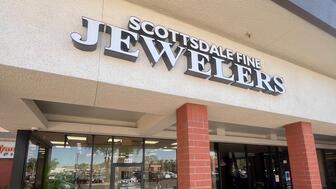The 23-carat fancy vivid blue diamond, set to headline Christie’s May jewelry auction, was expected to sell for as much as $50 million.
On Data: A 5-Point Reopening Checklist
Jewelers need to re-evaluate their sales forecasts, their inventory and their employees, writes Sherry Smith in this special edition of On Data.

The reopenings are happening sooner than we anticipated, but you still have time to complete your preparation and planning for the post-coronavirus world.
When the future is uncertain, creating multiple forecasts helps us prepare for different possibilities.
Planning and forecasting can play a major role in driving your success or failure, and nothing will bring you more peace of mind than reopening with a well-thought-out and detailed plan.
While there are many things you still feel you need or may want to do, the following items should be checked off your list prior to reopening.
1. Sales Projections
It will be incredibly difficult to predict what post-COVID-19 business will look like as none of us have been here before, but this doesn’t mean you shouldn’t complete your sales projections.
Although a sales projection is basically an educated guess, it does set the standard for your expenses, profits and growth.
You should aim to have three sales forecasts completed: a conservative, a moderate and an aggressive one, and you should absolutely factor in your data.
Your aggressive sales plan should be the remainder of your 2020 forecast from when you reopen. While this was created prior to the pandemic, this represents our aspirational goal of fully returning to pre-coronavirus business.
Your conservative and moderate sales plans should factor in the many potential variables you will be facing, such as fewer number of employees, your area’s potentially restricted schedules (days and/or hours, number of people allowed in the store, etc.), and a decreased marketing spend.
A hypothetical conservative sales plan might be 30 to 40 percent of your aggressive or original 2020 sales plan, and your moderate forecast might fall between 50 to 70 percent of your original sales plan for 2020.
2. Cash Flow Worksheet
One of the most important things you can do for your business right now is to create a financial budget.
Budgeting, in its simplest terms, is an outline of expectations for what a business wants to achieve for a particular period of time and, as we stated above, it represents your financial position, cash flow and goals.
While budgets generally forecast an entire year, yours should focus on the remainder of 2020.
Budgets afford you the luxury of tweaking as necessary and that’s precisely what you will need post-COVID-19.
Create three cash flow plans that tie directly to your conservative, moderate and aggressive sales plans.
Your revenue is made up of two components: your cost of goods sold and your gross profit. In theory, your cost of goods sold would cover your vendor payables and your gross profit should cover your operating costs.
If your sales plans (based on your gross margin) do not cover your operating costs, then you will need to look at either cutting some of the variable costs at least in the interim, or increasing your revenues or, preferably, both.
3. Savings
Hopefully, you’re a retailer who already saves a percentage of her or his revenue, but if you’re not, you must make this part of your business model moving forward.
Open a separate business account and determine the percentage you will start saving. I highly recommend 5 percent, but if you truly believe you cannot do that, start with 2 percent or 3 percent and work your way up to 5 percent, gradually ramping up to 10 percent.
The key is to start, and now is the perfect time. There are many benefits to having a business savings account, including being prepared for emergencies, budgeting for periodic expenses, and saving for future business projects.
4. Inventory Management
Currently, there is a lot of advice out there when it comes to inventory management after COVID-19.
Simply put, one size does not fit all. Having said that, never has it been more important for a retailer to follow best practices when it comes to managing her or his inventory.
Start with performing a vendor analysis as well as a category analysis prior to reopening.
This exercise typically shows that approximately 80 percent of your gross profit dollars are coming from as few as 10 to 15 vendors.
You’ll get the highest return on your efforts by starting with your top-performing vendors and categories.
Based on your findings, you should plan on remerchandising your store, not only to give your store a fresh look, but also to better align your top performers with your prime real estate.
One of your goals should be to work toward your optimum inventory level. Retailers can’t afford to have their working capital tied up in their inventory.
Imagine if you had that several hundred thousand dollars (or more) as cash in the bank going into this pandemic instead of having it tied up in non-performing product in your store. This crisis would be a lot less stressful for you.
When it comes to inventory, there are four areas to focus on and plan around.
- Fast-sellers. Commit to replenishing your fast-sellers. This is the very product driving revenue and creating cash flow.
- Memo. If memo is currently a successful part of your business model, then do not just blindly send it all back. You could find yourself starving your top-performing categories and vendors. Instead, do an analysis. Make sure your memo doesn’t compete with your assets, and never have aged memo except for the pieces generating orders.
- Aged. Given that cash flow is king, have a plan of action in place to aggressively target your aged inventory. Plan a clearance sale for your non-performing product. Your goal should be to recoup as much of your investment as possible and as quickly as possible. You should have a list of strategies ready to go for both reopening and ongoing management of aged inventory.
- Have conversations with your vendors. Collaborate on a preliminary sales plan and inventory goal for the remainder of 2020 you both feel comfortable working toward under these current circumstances.
5. Talent Management
Our people are our biggest asset as well as our biggest liability, and there is no better time to evaluate your team than right now.
When you reopen, you cannot afford to reopen with anything less than a really strong team, and that means having the right people in the right roles. This applies to both front and back of house.
RELATED CONTENT: What Will Retail Look Like After COVID-19?
If you have a sales team member who is dependable, reliable and has a great work ethic but simply cannot close a sale, consider shifting them to a different role, but only if it’s the right fit and is beneficial to your organization.
If you’ve done all these things and they’re still not a fit, you’re not doing your business or that employee any favors by keeping her or him.
Wrap-Up
To recap, while there are many things you could be working on, you should focus on completing this five-point checklist prior to reopening.
1. Create your sales plans.
2. Create your cash flow plans.
3. Open a business savings account.
4. Perform a vendor and category analysis and draft a remerchandising plan.
5. Evaluate and assess your team.
Do the work now. Tackle one item per day and you can complete your to-do list in as little as five business days.
Having your completed plan and contingency plans will help you reopen in the strongest position possible.
And, stay positive and continue to focus on the controllable.
I wholeheartedly admit I’m an optimist or, at the very least, a pragmatist. Therefore, I believe there are many people like myself—anxious to dine out, see a movie, frequent my favorite brick-and-mortar stores and, first and foremost, book an appointment at my local hair salon.
I leave you with this from quote from “Reengineering Retail” by Doug Stephens: “In a world where almost every aspect of our lives has been somehow digitized, experiences that engage our bodies, our senses and our souls are at a premium.”
The Latest

Emmanuel Raheb outlines the differences between the two platforms and posits that the most successful jewelers use both.

The miner said its April sale featured a mix of commercial-quality primary rubies and secondary rubies of varying quality.

Supplier Spotlight Sponsored by GIA

U.S. customs agents in El Paso, Texas, intercepted the package, which would have been worth $9 million if the jewelry was genuine.


Health monitors become statement pieces when paired with the brand’s new collection of stackable diamond-studded bands.

Ten organizations were selected this year.

Six new retail businesses were selected for the 2025 program, which began in January.

“Shell Auranova” is the next generation of the brand’s bridal line, featuring half-bezel engagement rings with bold and fluid designs.

Boucheron and Pomellato performed well in an otherwise bleak quarter for Kering amid struggles at Gucci.

Designer Deborah Meyers created her birds from oxidized sterling silver, rose-cut diamond eyes, and Akoya Keshi pearl feathers.

The company said it expects sightholders to remain “cautious” with their purchasing due to all the unknowns around the U.S. tariffs.

Sponsored by the Gemological Institute of America

Simon Wolf shares why the time was right to open a new office here, what he looks for in a retail partner, and why he loves U.S. consumers.

A third-generation jeweler, Ginsberg worked at his family’s store, Ginsberg Jewelers, from 1948 until his retirement in 2019.

The company failed to file its quarterly reports in a timely manner.

The organization also announced its board of directors.

Charms may be tiny but with their small size comes endless layering possibilities, from bracelets to necklaces and earrings.


Located in Valenza, the now 355,000-square-foot facility includes a new jewelry school that’s open to the public, Scuola Bulgari.

Paola Sasplugas, co-founder of the Barcelona-based jewelry brand, received the Fine Jewelry Award.

A platinum Zenith-powered Daytona commissioned in the late ‘90s will headline Sotheby’s Important Watches sale in Geneva next month.

The basketball stars wear men’s jewelry from the “Curb Chain” collection.

The Signet Jewelers-owned retailer wants to encourage younger shoppers to wear fine jewelry every day, not just on special occasions.

The 21 pieces, all from a private collector, will be offered at its Magnificent Jewels auction next month.

Lilian Raji answers a question from a reader who is looking to grow her jewelry business but has a limited marketing budget.

GCAL by Sarine created the new role to sharpen the company’s focus on strategic partnerships and scalable expansion.

The Indiana jeweler has acquired Scottsdale Fine Jewelers in Scottsdale, Arizona.





























